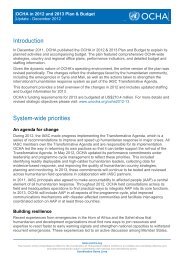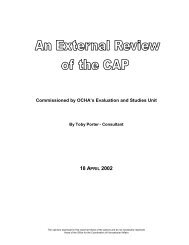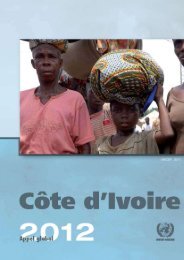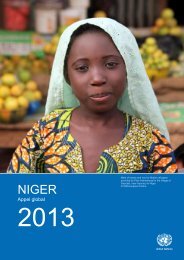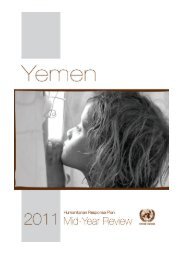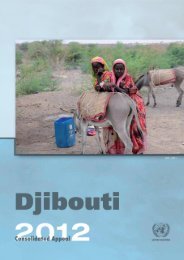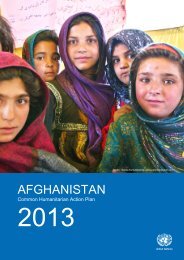Summary
Philippines: Bohol Earthquake Action Plan
Philippines: Bohol Earthquake Action Plan
- No tags were found...
You also want an ePaper? Increase the reach of your titles
YUMPU automatically turns print PDFs into web optimized ePapers that Google loves.
Philippines: Bohol Earthquake Action PlanOctober 2013This document outlines the humanitarian community’s response to the needs arising from the earthquake that struck Bohol. It was issued by thePhilippine Humanitarian Country Team in collaboration with partners. Figures are current to 23 October 2013.Highlights A 7.2 magnitude earthquake struck Boholprovince in central Philippines on15 October 2013. Over 344,300 people are displaced with80 per cent living in makeshift sheltersbuilt in open spaces near their damagedhomes. Government identified emergency shelter,early recovery, water, sanitation andhygiene (WASH), education, food,logistics and coordination as top priorityareas for support. This action plan seeks US$46.8 million toreach 344,300 people over a six-monthperiod until April 2014. Successive and simultaneousemergencies since August 2013 havestretched the resources of humanitarianresponders. Additional funding is urgentlyneeded for timely aid to reach the rightpeople.Map showing the extent of displacement in municipalities affected by the earthquake in Bohol province as of23 October 2013.Source: PHIVOLCS, GADM, OSM, NDRRMC, HCT-DSWD Assessment teamThe boundaries and names shown and the designations used on this map do not imply official endorsementor acceptance by the United Nations.7.2Magnitude on theRichter scale53,300Damaged houses2,500Aftershocks344,300People targeted forassistance6 monthsDuration fromOctober 2013 toApril 2014$46.8millionFunding requested<strong>Summary</strong>A major emergency response operation is underway in central Philippines following the 7.2 magnitude earthquakethat struck Bohol island on 15 October 2013 at 8:12 a.m. local time, at a depth of 32 kilometres. The tremorrecorded level VII out of X (‘destructive’ with level X as ‘completely devastating’) on the Philippine earthquakeintensity scale at the epicenter in Sagbayan municipality (population of 20,000 people), and it was felt across theCentral Visayas region (population of 6.8 million), according to the Philippine Institute of Volcanology andSeismology (PHIVOLCS). This is the strongest earthquake to hit Bohol in nearly 25 years, possibly caused by afault line unknown until the disaster.Municipalities in northwest Bohol were hardest-hit. At least 2,500 aftershocks were recorded since the first powerfulearthquake with 64 tremors strong enough to be felt. The epicenter of these aftershocks is gradually movingnorthwest towards Cebu island, and the tremors measuring levels II to III (‘slightly felt’ to ‘weak’) are expected tocontinue for another two to three weeks.A total of 195 people died, 651 injured and 12 still missing. The majority of casualties are reported in Bohol,according to the National Disaster Risk Reduction and Management Council (NDRRMC). The death toll could havebeen far worse if the earthquake struck on a regular weekday and not on a national holiday. Nevertheless, theearthquake caused landslides and extensive damage to housing, hospitals, schools, infrastructure and utilities, withmore than 53,300 houses severely damaged or destroyed. The number may still rise once emergency serviceteams are able to verify the data in all the affected areas.https://philippines.humanitarianresponse.info/
Bohol Earthquake Action Plan 2013 | 2More than 344,300 people are displaced, of whom 71,400 people (or 20 per cent) are staying in 99 evacuationcentres. The rest are living outside their collapsed homes in open spaces, roadsides and gardens or collectively inpublic spaces close to their homes, afraid that further quakes will bring down buildings. The families are buildingmakeshift shelters from salvaged materials and plastic sheeting. The main humanitarian needs are food, drinkingwater, tents, hygiene kits, sanitation facilities, sleeping materials, fuel, medicines and medical equipment, andpsychosocial support, which the Government, civil society and humanitarian actors are urgently mobilizing. Further,awareness of the warning signs in danger areas due to fissures and soil failure, should be raised among affectedfamilies.The provinces of Bohol and Cebu declared a state of calamity on 15 October. The economy of Bohol is largelybased on agriculture, with tourism playing an increasingly important role. Airports and seaports resumed operationsquickly, and by 21 October, access to most municipalities was restored. Telecommunications have also resumednormal service. However, 40 per cent of the households across the province are still without power, which isdisrupting access to safe drinking water and the cold chain for medicines. Classes have been suspended at leastuntil 28 October, and education will heavily rely on temporary learning spaces until school buildings are reestablished.Structural assessment and clearance of public buildings and residences are urgently needed.The provincial authorities are leading the relief effort with the support of national government. By the second weekof the disaster, search and rescue teams shifted to recovery operations, and the restoration of damaged roads andbridges, power and water systems is ongoing. Having distributed food to meet the immediate needs of the affectedpeople in the hardest-hit areas, the Department of Social Welfare and Development (DSWD) together with localgovernment units is now on the second cycle of food pack distribution to reach all people in need. Meanwhile, theDepartment of Health provided assorted drugs and medicines, and sent medical/surgical teams to the worstaffectedmunicipalities. The Philippine Red Cross, non-governmental organizations, charities and volunteers arealso delivering assistance.Despite the efforts, additional response is needed. On 21 October, the NDRRMC Chairperson welcomedinternational humanitarian assistance earlier offered by the Humanitarian Coordinator on behalf of theHumanitarian Country Team (HCT). This action plan outlines urgent needs; planned actions and fundingrequirement for this emergency in line with the Government’s priorities (see section on Priority Needs and Actions).Fourteen UN agencies, IOM, non-governmental organizations and partners are seeking US$46.8 million toimplement 23 projects across 13 sectors over a three to six month period to deliver aid to 344,300 people. Theaction plan will be revised towards the end of November 2013 to incorporate more complete and in-depthassessments.Reconstruction and recovery will take time, and recovery planning is critical at the early stages of the response.Early recovery is reflected in the document, closely tied to priority shelter activities. However, the implementation oflonger-term solutions that will take more than six months, such as access to land, housing and property issues, isoutside the scope of this action plan.The Philippines was affected by successive, multiple and simultaneous disasters in recent months. Humanitarianactors are responding to the protracted conflict situation in central Mindanao, the crisis in western Mindanao(September) and widespread flooding caused by the southwest monsoon rains and multiple typhoons (sinceAugust). Twenty-one tropical cyclones were recorded this year and more are expected before the typhoon seasonends in December. Northeast monsoons prevail in the earthquake-affected areas until December, which will furtherexacerbate the situation of the affected and vulnerable people.With resources stretched, the humanitarian agencies are focused on ensuring an effective, needs-based responseunder the leadership of the Government. HCT’s targeted support will complement Government’s responsecapacity. This initial action plan draws on the findings of rapid needs assessments undertaken jointly by theGovernment and the HCT members as well as by clusters, individual agencies, the Philippine Red Cross anddonors. Details of the assessments are available at: https://philippines.humanitarianresponse.info/assessmentregistry/table/locations/bohol.Additional assessments are ongoing and planned to fill information gaps.Table 1. Figures on evacuees, evacuation centres and damaged houses by province in Region VIIRegions/ProvincesNo. ofevacuationcentresInsideevacuationcenters(person)Displaced peopleNot inevacuationcentres(person)TotalTotal Affected(person)TotalPopulationDestroyedHousesPartiallyDamagedBohol 74 65,948 266,025 331,973 1,135,044 1.2 million 52,477 38,484Cebu 25 5,439 6,888 12,327 1,829,719 2.6 million 15 822Total 99 71,387 272,913 344,300 2,964,730 3.8 million 52,492 39,306Source: NDRRMC Sitrep No.17 on Effects of Magnitude 7.2 Sagbayan, Bohol Earthquake, 23 October 2013, 6 a.m.; National Statistics Office, 2010 Census of Population and Housinghttps://philippines.humanitarianresponse.info/
Bohol Earthquake Action Plan 2013 | 3General CoordinationThe provincial government of Bohol is leading the overall relief efforts with the support of national authorities.Response coordination is structured around sectors such as infrastructure (logistics and lifelines), social services(emergency shelter, camp management, food, protection) and other areas including health, education, agriculture,environment, security, and trade and industry.Key humanitarian clusters are active at the provincial level, primarily led by national authorities and co-led byinternational agencies. These clusters are identifying ways to interact with local authorities, to whom the clusterapproach is a new concept, in order to work more effectively together. Advocacy on humanitarian principles,equitable and efficient distribution of aid, two-way communication between the responders and the affectedcommunities are key to ensuring aid is delivered where it is required. The coordination structure will evolve as moreresponders establish their presence in Bohol and according to the phases of the emergency.Priority Needs and ActionsThe HCT will provide targeted support to complement Government’s response capacity and address the urgenthumanitarian needs of the most vulnerable people affected by the Bohol earthquake. Priority needs as articulatedby the national disaster management authority are: Coordination Emergency shelter, including tents Early recovery, including debris removal, rehabilitation of public building and demolition of condemnedstructures WASH with a focus on sustainable access to clean drinking water, provision of hygiene kits, and portable toilets Education, including temporary learning spaces Food Logistics, with mobile storage units, warehousing and transport assistanceThe HCT also identified health, psychosocial support, camp coordination and camp management (CCCM),nutrition, protection, livelihoods and agriculture as critical for the humanitarian relief and recovery.Emergency ShelterContact Information: Patrick Elliott (patrick.elliott@ifrc.org; +63-908-401-1218)Currently over 53,000 houses are reported severely damaged or destroyed. Familieslive in the open, under cramped, hastily built makeshift structures from thin used tarpsand other salvaged materials that provide inadequate shelter. Shelter materials arescarce as businesses remain closed due to damage.$9.7 millionFunding requirementThe shelter cluster deployed the REACH assessment team to support the government in order to determine thespecific shelter needs of men and women of different ages and with different vulnerabilities. The cluster will focuson immediate life-saving shelter interventions. 35,000 families will be provided with plastic sheeting or tents, some tools and fixtures and basic non-food items(NFI). This should provide adequate shelter through the imminent rainy season - at least three months. Longerterm solutions will also be required. To complement the government’s contribution of Philippine peso 5,000 ($116) for a damaged house andPhp10,000 ($231) for a destroyed house, the cluster also targets 5,000 vulnerable families for transitionalshelter. Damage assessment for housing safety, technical assistance and training to women and men will be provided inimplementing safer earthquake resistant building practices.Early RecoveryContact Information: Toshihiro Tanaka (toshihiro.tanaka@undp.org; +63-2-901-0236)As of 21 October, initial reports indicate extensive damage to housing, and most of thebasic service infrastructures such as health centres, hospitals and schools have eithercollapsed or their structural integrity compromised rendering them unsafe for use. The$5.1 millionFunding requirementhttps://philippines.humanitarianresponse.info/
Bohol Earthquake Action Plan 2013 | 4same is true with governance infrastructures such as municipal and barangay halls, markets and gymnasiums.Substantial response is expected to last several years. The following actions are immediately required: Clear rubble and debris through cash-for-work activities; reduce health risks while providing income to affectedpeople and stimulating the local economy Provide comprehensive debris management support to local government units including recovery of recyclablematerials and safe final disposal of both earthquake and domestic wastes Support the construction/repair of community service infrastructures Enhance community resilience through mainstreaming disaster risk reduction and management into earlyrecovery interventions to reduce vulnerability and sense of insecurity; promote unity and community self-helpWater, Sanitation and HygieneContact Information: Tomoo Hozumi (thozumi@unicef.org; +63-2-901-0124)$8 millionFunding requirementDamage to the water sources; pipelines, pumping stations and the electricity supply, allaffect the availability of drinking water. Several water treatment units were deployed butnot all needs are covered. Most families obtain water from hand pumps and springs but quality is doubtful and thewater is likely to be contaminated. Some water trucks are available but insufficient to cover all evacuation centres,let alone the displaced people. Water tanks and household water containers are needed for safe storage.Meanwhile, toilets are damaged and clogged due to the lack of water. Open defecation is rampant and should beaddressed. Displaced families do not have access to hygiene items like soap and women have no access tosanitary napkins.The risk of disease outbreak is great under such conditions. Vulnerable groups, like women and children, are athighest risk of morbidity and mortality. WASH needs should also be addressed in temporary relocation sites,temporary hospitals and learning spaces, and child friendly spaces. The following urgent actions are required: WASH Cluster coordination Monitor WASH access and undertake water quality surveillance Install mobile water treatment units, water bladders and water points, and drainage from WASH facilities Rehabilitate water source and supply systems Distribute water and hygiene kits Construct gender-segregated emergency latrines and bathing facilities with operations and maintenance andwaste disposal Conduct hygiene promotion sessions Manage solid wasteEducationContact Information: Tomoo Hozumi (thozumi@unicef.org; +63-2-901-0124)The Bohol Earthquake disrupted children’s education throughout the Central Visayasregion. The worst-hit were schools in Sagbayan close to the epicenter. Classes were$2.5 millionFunding requirementsuspended, and pre-schoolers and school children, and their families suffered severe stress. The province of Boholalone accounts for 206,394 elementary and 69,461 high school children, covering 80 per cent (873) of the schools.The damage to education infrastructure is extensive. Children should go back to school as soon as possible so thatthey can begin a process of fast recovery and normalization. The Education Cluster will: Set up temporary learning spaces to restore children’s learning environment and bring back the rhythm ofschooling, which is crucial to their psychological well-being and sense of future direction Replace damaged or lost teaching and learning materials Enhance disaster risk reduction-related knowledge, skills and system on the part of the school, families and thecommunityhttps://philippines.humanitarianresponse.info/
Bohol Earthquake Action Plan 2013 | 5Food SecurityContact Information: Praveen Agrawal (praveen.agrawal@wfp.org; +63-2-750-2561)Based on rapid needs assessments and priorities expressed by the Government, theFood Security Cluster aims to provide life-saving and early recovery assistance to100,000 worst-affected people in Bohol. Three programme modalities will be launched tomitigate short-term hunger but also to contribute to the longer-term restoration of foodand nutrition security in the affected areas.$4 millionFunding requirement Together with DSWD, the cluster will immediately provide vital emergency food assistance through targeteddistribution (100,000 people) School feeding in emergency will be implemented, together with the Department of Education, which will providedaily nutritious meals to school-going children (15,000 students) so that their education remains uninterruptedand children regain a sense of normalcy As the earthquake devastated household, agricultural and horticultural assets, the cluster will undertake foodfor-workactivities (10,000 participants) to allow for productivity-enhancing investments in rehabilitation, assets,and livelihoodsLogisticsContact Information: Praveen Agrawal (praveen.agrawal@wfp.org; +63-2-750-2561)$1 MillionFunding requirementThe earthquake caused significant damage to public buildings, warehouses, ports,electric power distribution system and road infrastructure. As the humanitariancommunity scales up its relief response in order to address the request from thePhilippine Government for life-saving and life-sustaining relief items, there is a needed for immediate provision oflogistics support to the government and wider humanitarian community.The cluster will provide logistics support through the four main activities: (1) logistics coordination; (2) warehousing;(3) transport; (4) provision of logistics equipment.Two mobile logistics hubs with staff will be deployed to Tagbilaran and Tubigon as main entry points of province ofBohol. One mobile storage unit will be established at Tagbilaran City Airport to facilitate transit and consolidation ofhumanitarian relief items in close coordination with the Office of Civil Defense, DSWD and HCT. Tactical logisticssupport will be availed to the Government including prioritized clusters through the provision of ad hoc transportservices. Local transport companies will be hired in Bohol and Cebu for the forward movement of the relief cargo toareas within Bohol in need of assistance.HealthContact Information: Dr. Julie Hall (hallju@wpro.who.in; +63-2-528-9761); Reproductive Health: Sew Lun Ah Sue(ahsue@unfpa.org; +63-2-901-0302)$6.8 millionFunding requirementMany health facilities sustained severe damage, disrupting the delivery of essentialhealth services. Partial assessments reported 136 health facilities damaged, of which111 were partially damaged and 25 totally destroyed. More than 344,700 displaced people need essential healthservices. There is a large vulnerable elderly population (i.e. chronic health conditions). Assessments are showingthe following priorities: Increase provision and access to essential health services (i.e. medical/surgical consultations, reproductivehealth, mental health, psychosocial support, health promotion, immunization) Strengthen disease surveillance and outbreak control Strengthen referral system from community health facilities to higher levels of care Provide support to systematic immunization for vaccine preventable disease outbreaks Establish temporary health facilities/ services and/or repair/rehabilitate damaged health facilities Provide support to information management and to the coordination of the health sector responseReproductive health assessment found that: birthing facilities were completely damaged, deliveries performed inmakeshift tents. Temporary hospitals needed as complex deliveries referred to Tagbilaran city; emergency obstetricequipment installed to avoid a rise in maternal deaths. The Bohol Governor requested UNFPA to help affectedhttps://philippines.humanitarianresponse.info/
Bohol Earthquake Action Plan 2013 | 6pregnant and lactating women (PLWs) and other women of reproductive age (WRAs) in the province; WHO and thePhilippine Red Cross to set-up temporary hospitals; UNFPA to provide reproductive health (RH) kits for normaldelivery caesarian operation and blood transfusion. Each kit can serve a population of 30,000. Conduct RH medical missions to give women access to RH information and services Deploy mobile medical team to provide prenatal, natal and post-natal care to PLWs and family planning andsexually transmitted infections, HIV/AIDS services to WRAs and men. Target is10,000 women/men of which3,000 are PLWs Distribute hygiene kits Build capacity of the local health service providers to sustain RH interventions and provide RH equipment toreconstructed rural health units and birthing facilitiesCamp Coordination and Camp ManagementContact Information: Marco Boasso (mboasso@iom.int; +63-2-230-1777)The Joint Rapid Needs Assessment undertaken by DSWD and several members of theHCT emphasize that the majority of the immediate caseload for assistance is staying inopen spaces of the evacuation centres due to trauma, immediate threat of falling debrisfrom damaged structures and ongoing aftershocks. Based on the 2010 Census, the$800,000Funding requirementBohol population ratio is almost equal for women and men. CCCM cluster co-lead is assisting the Government withthe activation of the CCCM Cluster. The urgent needs identified by the cluster are: Displacement Tracking Matrix report for displaced people in private lots and public evacuation spaces (e.g.open school grounds, plaza). This report will be regularly shared with humanitarian actors. CCCM training of local camp managers addressing two types of evacuation spaces – public and private openspaces, and internally displaced persons (IDP) settlement planning in coordination with the Shelter Cluster 92,500 displaced people provided with camp management information and support activities Humanitarian communications including appropriate information on disaster risk response of the humanitarianactors, counter-trafficking issues and supportive psychosocial communication and information on problems forthe affected communitiesNutritionContact Information: Tomoo Hozumi (thozumi@unicef.org; +63-2-901-0124)$2 millionFunding requirementAn estimated 50,000 children under the age of five years, 13,300 pregnant women and22,900 lactating women were displaced. With primary health care and WASH facilitiesdamaged, and family support systems and livelihood activities disrupted, an estimated1,200 children of 6-23 months are at risk of severe acute malnutrition, 3,000 children at risk of moderate acutemalnutrition and 4,200 at risk of global acute malnutrition, 3,300 pregnant women and 4,100 lactating women,respectively, at risk of malnutrition including micronutrient deficiencies. A nutrition response is urgently needed toensure that the nutrition status among the affected people do not deteriorate beyond pre-emergency prevalence.The Nutrition Cluster will: Conduct immediate Vitamin A supplementation, deworming and measles vaccinations for children 6 to 59months; iron folic acid to pregnant and lactating women Strengthen the protection and promotion of breastfeeding in emergencies Strengthen infant and young child feeding counseling to lactating women Establish community management of acute malnutritionProtectionContact Information: Protection: Bernard Kerblat (kerblat@unhcr.org; +63-2-818-5121); Child Protection: Tomoo Hozumi(thozumi@unicef.org; +63-2-901-0124); Gender-based Violence: Sew Lun Ah Sue (ahsue@unfpa.org; +63-2-901-0302)Child Protection: Destruction of homes, schools and community facilities has causedsevere disruptions to the normal life and safety of children in the area affected by Bohol$1 millionFunding requirementhttps://philippines.humanitarianresponse.info/
Bohol Earthquake Action Plan 2013 | 7Earthquake. The capacity of families protecting children and community mechanisms was disrupted, thusexacerbating the vulnerability of children. Risks of trafficking, exploitation and abuse have increased. The followingactions are urgently needed: Conduct a Child Protection Rapid Assessment Set up child-friendly spaces and psychosocial support Facilitate family tracing and reunification and referral pathways Information dissemination on prevention and response to child abuse, exploitation, violence, child trafficking Strengthen local councils for the protection of children, and Anti-Trafficking Task Forces Strengthen convergence of Child Protection Working Group and GBV sub-Cluster with other humanitarianclusters Orientation of social workers, camp managers, service providers, law enforcers, humanitarian workers,volunteers on the code of conduct in humanitarian workGender-Based Violence: The GBV rapid assessment reports many cases of trauma among women and childrenbut none for GBV. Most of the evacuation sites lack latrines and bathing facilities. Security is a concern at night asthere are no roving police patrols. Lack of livelihood and productive employment can make women and girlsvulnerable to trafficking. The SGBV sub-Cluster will: Closely work with the CCCM to address protection concerns, and work with the Shelter, Livelihood and EarlyRecovery Clusters to ensure that gender perspectives and GBV prevention are mainstreamed in theirprogrammes Provide psychosocial support services to women traumatized by the disaster Establish women-friendly spaces (WFS) where temporary shelters will be built Orient camp managers on GBV prevention measures and conduct GBV information sessions in WFS Strengthen the Local Committee against Trafficking and Violence Against Women and Children at the provincialand municipal levels for sustainability in addressing the protection concerns of women and childrenLivelihoodContact Information: Jeff Johnson (johnsonl@ilo.org; +63-2-580-9919)$4.4 millionFunding requirementCritical public infrastructure such as schools and health centres will require debrisclearing while using labor-based technologies that will infuse and retain available fundsinside the community. The Livelihood cluster aims to provide at least 22,256 - or 10 percent of the total families affected in Bohol - with emergency employment activities. Rapid livelihood assessmentindicates that laborers and unskilled workers, farmers, fishermen, forestry workers, service workers, shop andmarket sales workers need immediate employment and livelihood support. The following actions are urgentlyneeded: Emergency employment to support debris clearing, reconstruction of public infrastructures such as schools andhealth centres, and construction of temporary shelter and support facilities Skills training, capacity development and mentoring initiatives to provide alternative livelihood opportunities andensure the sustainability of these interventions in the medium to long term to revitalize key economic driverssuch as agriculture and tourism industry Provide workers with social benefits, protective gears, equipment and toolsAgricultureContact Information: Aristeo Portugal (Aristeo.Portugal@fao.org; +63-2-901-0353)Initial reports from the Department of Agriculture and the Department of Agrarian Reformindicate that crop losses were minimal as farmers had already harvested most of their$900,000crops. However, agricultural infrastructure, particularly irrigation and post-harvestFunding requirementfacilities, are affected. It is critical that vulnerable farmers receive agricultural inputs forthe upcoming cropping season beginning in December so they can continue their livelihood activities and focustheir available resources on rebuilding their damaged houses, recovering lost/damaged productive assets, andmeeting other household needs. Priority interventions of the Agriculture Cluster include:https://philippines.humanitarianresponse.info/
Bohol Earthquake Action Plan 2013 | 8 Ensure that rice, corn and assorted vegetable seeds and sets of garden tools are distributed to help restore theagriculture-based livelihoods of approximately 17,500 households, ensuring that the cycle of subsistencefarming is not disruptedCoordinationContact Information: David Carden (carden@un.org; +63-2-901-0265)$450,000The response to this earthquake requires a concerted action by numerous actors across Funding requirementmultiple sectors. Following the usual practice in the Philippines, international actors areorganizing themselves to complement existing local response mechanisms. Coordination with authorities at alllevels (national, provincial to municipal) and inter-sectoral coordination among all partners are critical to ensure thatall actors work better together to assess needs, plan, secure funds, implement and monitor activities. Upon Government’s request, HCT will support the authorities to orient local actors on the cluster system. At the same time, HCT will advocate for principled humanitarian action and share relevant best practices. Information products such as situation reports, Who-does-What-Where and thematic maps, contact lists,meeting schedules and a needs assessment registry are produced to support partners with the tools for swiftdecision-making and planning. Take initiatives to improve a two-way communication between the humanitarian community and the affectedpeople.Emergency TelecommunicationsContact Information: Praveen Agrawal (praveen.agrawal@wfp.org; +63-2-750-2561)A Télécoms Sans Frontières (TSF) team deployed from Bangkok on 18 October to provide telecommunicationsupport in the disaster affected areas. The team set up internet connection and humanitarian calling operations inthe worst-hit municipalities of Loon, Maribojoc and Sagbayan. TSF also provided humanitarian calling operationsthroughout Bohol within the first few days. TSF completed its operation on 22 October as electricity was restoredand telecommunication network was fully operational in Bohol. Overall, TSF provided means of communications to600,000 families affected by the disaster.FundingMulti-lateral assistance: The United States allocated $50,000 of emergency response funds to provide NFIs toearthquake-affected communities through Plan International. USAID also provided logistical assistance to DSWDthrough WFP. On 19 October, the Disaster Relief Emergency Fund of the International Federation of the Red Cross(IFRC) allocated Swiss francs 499,911 ($1.7 million) to support the Philippine Red Cross deliver immediateassistance to 10,000 families for three months. Further, the IFRC launched an emergency appeal on 24 Octoberseeking CHF5.4 million ($6.1 million) to enable the Philippine Red Cross to scale up its response.Bilateral assistance: On 17 October, the Republic of Korea contributed $300,000 for recovery work in theearthquake-struck areas. The Taiwanese Government donated $100,000 to support relief and rehabilitation workon 18 October.To All humanitarian partners, including donors and recipient agencies, are encouraged to inform OCHA’s Financial Tracking Service (FTS – http://fts.unocha.org) ofcash and in-kind contributions by emailing: fts@un.org.https://philippines.humanitarianresponse.info/
Annex I: Requirements per cluster and agencyBohol Earthquake Action Plan (October 2013 - April 2014)as of 24 October 2013Philippines – Bohol Earthquake Action Plan | 9ClusterRequirements($)Agriculture 900,001Camp coordination and camp management 800,000Coordination 450,000Early recovery 5,130,000Education 2,500,000Emergency shelter 9,716,450Food security 4,000,000Health 6,839,000Livelihood 4,423,515Logistics 1,000,000Nutrition 2,000,000Protection 1,000,000Water, sanitation and hygiene 8,000,000Grand Total 46,758,966Bohol Earthquake Action Plan (October 2013 - April 2014)as of 24 October 2013Appealing organizationRequirements($)ADRA 500,000CRS 2,379,887FAO 900,001HFHI 1,622,750ILO 4,423,515IOM 5,800,000OCHA 450,000SC 820,178UNDP 5,130,000UNFPA 2,300,000UNICEF 12,179,822WFP 5,000,000WHO 4,539,000WVI 713,813Grand Total 46,758,966Compiled by OCHA on the basis of information provided by appealing organizations.The list of projects and the figures for their funding requirements in this document are a snapshot as of 24 October 2013. For continuously updatedinformation on projects, funding requirements, and contributions to date, visit the Financial Tracking Service (fts.unocha.org).https://philippines.humanitarianresponse.info/
Philippines – Bohol Earthquake Action Plan | 10Annex II: List of projectsProject code Title Appealing agency RequirementsAgriculturePHI-13/A/59978/123Emergency response to restore the rural livelihoods of earthquakeaffectedhouseholds in Bohol Province($)FAO 900,001Sub-total for Agriculture 900,001CCCMPHI-13/CSS/60013/298CCCM and Emergency Shelter Support for Affected Populations inthe Bohol EarthquakeIOM 800,000Sub-total for CCCM 800,000CoordinationPHI-13/CSS/59992/119Strengthening humanitarian coordination and advocacy inearthquake-affected areas in Central Visayas, PhilippinesOCHA 450,000Sub-total for Coordination 450,000Early RecoveryPHI-13/ER/59970/776Time Critical Debris Management in Areas Hardest Hit by theBohol EarthquakeUNDP 5,130,000Sub-total for Early Recovery 5,130,000EducationPHI-13/E/59976/6079PHI-13/E/59989/124Response to Education Needs of Children Affected by the BoholEarthquakeBohol Earthquake: Providing life-sustaining psychosocial supportand education in emergency response to affected preschoolersand school children in worst-hit municipalitiesSC 620,178UNICEF 1,879,822Sub-total for Education 2,500,000Emergency ShelterPHI-13/S-NF/59972/5146 Bohol Earthquake Transitional Shelter Response CRS 2,187,500PHI-13/S-NF/59973/5146 Bohol Earthquake Emergency Shelter Response CRS 192,387PHI-13/S-NF/59974/7250 Rebuild Bohol HFHI 1,622,750PHI-13/S-NF/59979/8502 Central Visayas Earthquake Emergency and Recovery Response WVI 713,813PHI-13/S-NF/59991/6579 Emergency Shelter for Earthquake Response in Bohol ADRA 500,000PHI-13/S-NF/60003/298Emergency Shelter for Affected Populations in the BoholEarthquakeIOM 4,500,000Sub-total for Emergency Shelter 9,716,450Food SecurityPHI-13/F/59987/561Life-saving and early recovery food assistance to the peopleaffected by Bohol earthquakeWFP 4,000,000Sub-total for Food Security 4,000,000HealthPHI-13/H/60010/122PHI-13/H/60011/298PHI-13/H/60041/1171Provision of emergency health services to earthquake affectedpopulationsEnhancing Access to Emergency Health Care, Referral Servicesand Mental Health and Psychosocial Support for Earthquakeaffected IDPs in Evacuation Centers and Displacement Sites inBoholAccess to Reproductive Health Services for the IDPs of the BoholEarthquakeWHO 4,539,000IOM 500,000UNFPA 1,800,000Sub-total for Health 6,839,000LivelihoodPHI-13/A/60033/5104Community-based Emergency Employment and Reconstructionproject in Bohol provinceILO 4,423,515https://philippines.humanitarianresponse.info/
Philippines – Bohol Earthquake Action Plan | 11Project code Title Appealing agency RequirementsSub-total for Livelihood 4,423,515LogisticsPHI-13/CSS/60005/561Logistics Augmentation in support of the Government of thePhilippines response to earthquake in Bohol($)WFP 1,000,000Sub-total for Logistics 1,000,000NutritionPHI-13/H/60027/124 Bohol Earthquake: Life-saving nutrition response to children 0-59months, pregnant and lactating women affected by Boholearthquake emergencyUNICEF 2,000,000Sub-total for Nutrition 2,000,000Protection, including Child Protection and SGBVPHI-13/P-HR-RL/60001/124PHI-13/P-HR-RL/60044/1171Strengthening the Protective Environment for Children Affected bynatural disaster/displacement in Bohol Province and Cebu cityGBV Interventions for Affected Women and Girls in the BoholEarthquakeUNICEF 500,000UNFPA 500,000Sub-total for Protection, including Child Protection and SGBV 1,000,000WASHPHI-13/WS/59983/6079PHI-13/WS/59985/124WASH in Emergency services and supplies provision to disasteraffected children and familiesEnsuring WASH services for Earthquake Affected Populations inBoholSC 200,000UNICEF 7,800,000Sub-total for WASH 8,000,000Grand Total: US$ 46,758,966Compiled by OCHA on the basis of information provided by appealing organizations.https://philippines.humanitarianresponse.info/
Philippines – Bohol Earthquake Action Plan | 12Annex III: Agency overviewsNameHeadquartersWebsiteAdventist Development and Relief Agency Philippines (ADRA) Foundation Inc.Philippineswww.adra.phHQ Contact Cindy Bankhead, Program/Country Director, cindy@adra.ph, +63 917 586 7106Philippines Contact Jelome Manalu and Moises MusicoClusters / Sectors Shelter and NFIPresence, staff PO Box 25 JP Rizal, Sabutan; Silang, Cavite Philippines 4118NameHeadquartersWebsiteCatholic Relief Services (CRS)Baltimore (USA)www.crs.orgHQ Contact Jennifer Holst, Public Donor Liaison, Jennifer.holst@crs.org, +1-410-9517394Philippines Contact Joseph Curry, Country Representative, josephcurry@crs.org, +63-917544-4277Clusters / SectorsObjectivePresence, staffNameHeadquartersHQ ContactPhilippines ContactClusters / SectorsObjectivePresence, staffNameHeadquartersWebsiteHQ ContactWASH, ShelterCRS approaches its emergency response programming through a framework of savinglives, supporting livelihoods and strengthening civil society. From the very beginning of adisaster, CRS works with the affected community with the ultimate goal of moving fromrelief to reconstruction. CRS adheres to international standards to the greatest extentpossible in all of its emergency work to ensure that disaster-affected people are at leastable to meet their basic right to live a life with dignity. CRS works directly with affectedcommunities and local partners to help restore and strengthen their pre-disaster capacities.Country Office in Manila; field offices in Davao, Tagum, Cateel and recently established inTagbilaran. Total staff of 98 national staff and 4 international staff.Food and Agriculture Organization (FAO)Viale delle Terme di Caracalla, 00153 Rome (Italy)Dominique Burgeon, TCE Director, Dominique.Burgeon@fao.orgAristeo Portugal, Assistant FAO Representative (Programme), aristeo.portugal@fao.orgAgricultureAchieving food security for all is at the heart of FAO's efforts – to make sure people haveregular access to enough high-quality food to lead active, healthy lives. FAO’s mandate isto improve nutrition, increase agricultural productivity, raise the standard of living in ruralpopulations and contribute to global economic growth.Country Office in Manila, field offices (39 national staff members, of which 7 national staffare in Cotabato City)Habitat for Humanity InternationalHabitat for Humanity Philippineswww.habitat.org.phCharlie Ayco, charlie.ayco@habitat.org.ph (independent)Philippines Contact Charlie Ayco, charlie.ayco@habitat.org.ph, +62-905-2547645Clusters / SectorsPresence, staffNameHeadquartersWebsitePhilippines ContactClusters / SectorsObjectiveShelterHabitat for Humanity Philippines, 3f Paseo 111 Building, Paseo de Roxas corner LegazpiStreets. Makati City, Metro Manila Philippines: Tel. (+632) 846-2177International Labour Organization (ILO)Geneva (Switzerland)http://www.ilo.org/phLawrence Jeff Johnson, johnsonl@ilo.orgLivelihoodThe main aims of the ILO are to promote rights at work, encourage decent employmentopportunities, enhance social protection and strengthen dialogue on work-related issues.The ILO Country Office for the Philippines strives with partners to achieve decent andproductive work for all. After a major national disaster or other crisis, ILO CO Manilathrough its Employment Investment Intensive Programme (EIIP) aims to address quickrecovery of jobs and livelihoods affected through short-term, cash-for-work schemes, cashtransfer mechanisms and community based livelihood recovery initiatives.https://philippines.humanitarianresponse.info/
Philippines – Bohol Earthquake Action Plan | 13Presence, staffNameHeadquartersWebsiteHQ ContactPhilippines ContactClusters / SectorsObjectivePresence, staffNameHeadquartersWebsiteHQ ContactPhilippines ContactClusters / SectorsObjectiveIt has approximately 50 staff with 6 local staff working on EIIP related programmes inresponse to Tropical Storm Washi in Cagayan de Oro and Iligan, Typhoon Pablo in DavaoOriental and the Zamboanga conflict in Zamboanga City.International Organization for Migration (IOM)Geneva (Switzerland)www.iom.intCarol San Miguel, Donor Relations Division, drd@iom.intMarco Boasso, Chief of Mission, mboasso@iom.intCCCM, NFI, ShelterIOM, as global cluster lead in the IASC CCCM for natural disasters, promotes durablesolutions for internally displaced persons communities and local authorities within amigration crisis operations framework. Our approach integrates gender and rights-basedorientation, climate-smart risk reduction objectives including migration as adaptationstrategy. In the Philippines, IOM is the co-lead agency for emergency shelter.Country office in Manila, sub/field offices in Cotabato City, Zamboanga City, Tagum andCateel (400 international and national staff for the Mission and the Global ManilaAdministrative Center, of which 11 national staff currently in Zamboanga City, and 2national staff in Bohol)MERLINLondon (UK)www.merlin.org.ukGabor BeszterczeyKaren CulverHealth, Mental Health and Psychosocial SupportProvide basic primary emergency curative and preventative health care, mental health andpsychosocial support servicesPresence, staff 1 country office in Makati City, field offices in Davao Oriental and in Zamboanga City (2international, 9 national staff in Zamboanga City and 18 in Mati City, Davao Oriental, and 4national staff in country office). A roster of medical professionals is awaiting deployment toBohol.NameHeadquartersWebsiteHQ ContactPhilippines ContactClusters / SectorsPresence, staffNameHeadquartersWebsiteHQ ContactPhilippines ContactClusters / SectorsShelter Box(UK)www.shelterbox.orgShelter Box; International, Unit 1A, Water- Ma-Trout, Helston City, Cornwall, TR13 OLW,UKSonny Ongkiko - Shelter Box Response Manager, Philippines Disaster Relief,joseongkiko@yahoo.com, +63 917 3232361, shelterboxphilippines@gmail.comShelter tents and NFISonny OngkikoUnited Nations Children’s Fund (UNICEF)New York (USA), Geneva (Switzerland)www.unicef.org / www.unicef.org/nutritionclusterJosephine Ippe, Global Nutrition Coordinator, jippe@unicef.orgTomoo Hozumi, thozumi@unicef.orgTimothy Grieve, Chief of WASH, tgrieve@unicef.orgEducation, Nutrition, Child Protection, WASHObjective Girls, boys, women and men have protected and reliable access to sufficient safewater, sanitation and hygiene facilities. UNCIEF support for essential services and interventions to protect children andprevent their exposures to exploitation, abuse and violence.Presence, staffCountry Office WASH section (1) International Staff – Chief WASH; (1) WASH Specialist;(1) WASH Officer (1) National WASH Cluster Coordinatorhttps://philippines.humanitarianresponse.info/
Philippines – Bohol Earthquake Action Plan | 14NameHeadquartersWebsitePhilippines ContactClusters / SectorsNameHeadquartersWebsiteHQ ContactPhilippines ContactClusters / SectorsObjectivePresence, staffNameHeadquartersWebsiteHQ ContactPhilippines ContactClusters / SectorsObjectivePresence, staffNameHeadquartersWebsitePhilippines ContactClusters / SectorsObjectivePresence, staffNameHeadquartersWebsiteHQ ContactPhilippines ContactClusters / SectorsObjectivePresence, staffUnited Nations Development Programme (UNDP)New York (USA)www.undp.orgToshihiro Tanaka, Country Director, toshihiro.tanaka@undp.orgEarly RecoveryUnited Nations Office for the Coordination of Humanitarian Affairs (OCHA)New York (USA), Geneva (Switzerland)www.unocha.orgÖzgül Özcan, Desk Officer, ozcan@un.orgDavid Carden, Head of Office, carden@un.orgCoordinationOCHA mobilizes humanitarian assistance for all in need. OCHA delivers its mandatethrough coordination, policy development, advocacy, information management andhumanitarian financing.Country Office in Manila, field offices / hubs in Cotabato City, Zamboanga City(7 international and 17 national staff members, of which 2 international and 4 national staffare in the new office in Bohol)United Nations Population Fund (UNFPA)New York (USA)www.unfpa.org.phUgochi Daniels, Chief, Humanitarian and Fragile Context BranchGenevieve Ah Sue, Representative, a.i., ahsue@unfpa.orgSGBV Sub-cluster under the Protection ClusterReproductive Health Working Group under the Health ClusterIn times of crisis, recovery and beyond, UNFPA is committed to focus our efforts towardsdelivering a world where every pregnancy is wanted, every childbirth is safe and everyyoung person’s potential is fulfilled.Country Office in Manila, humanitarian field offices / hubs in Cotabato City and ZamboangaCity and regular field offices in 10 provinces and Davao City.The core Humanitarian Team has 8 staff. Surge capacity consists of 5 Country Office staffand 5 regular field staff.World Food Programme (WFP)Rome (Italy)www.wfp.orgPraveen Agrawal, Representative and Country Director, Praveen.agrawal@wfp.orgFood Security. LogisticsProvide life-saving and early recovery food assistance to earthquake affected householdsand ensure rapid delivery of life-saving items to the affected population as prioritized by theGovernment and Humanitarian Country TeamCountry Office in Manila, sub-offices in Cotabato City, Iligan, Davao, Zamboanga (soon inBohol); total staff 141 (11 international; 130 national)World Health Organization (WHO)Geneva (Switzerland)www.wpro.who.int/philippinesCintia Diaz-Herrera, diazherrerac@who.intDr Julie Lyn Hall, WHO Representative, hallju@wpro.who.intHealthTo support Member States and local health authorities to lead a coordinated and effectivehealth sector response together with the national and international community, in order tosave lives, minimize adverse health effects and preserve dignity, with specific attention tovulnerable and marginalized groups.Country office in Manila (12 international staff, 38 national staff), field offices in CotabatoCity (3 national staff) and Zamboanga City (4 national staff), regional office support (5international staff)https://philippines.humanitarianresponse.info/
Philippines – Bohol Earthquake Action Plan | 15NameHeadquartersWebsitePhilippines ContactClusters / SectorsPresence, staffWorld Vision PhilippinesWorld Vision Philippineswww.worldvision.org.phErnie Macabenta, Associate Director for Operations, Visayas, Ernie_Macabenta@wvi.orgShelter and NFIFlorelyn “Bebeth” Tiu, +639178179911, bebeth_tiu@wvi.org389 Quezon Avenue, 1104 Quezon City, Philippineshttps://philippines.humanitarianresponse.info/



